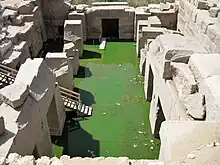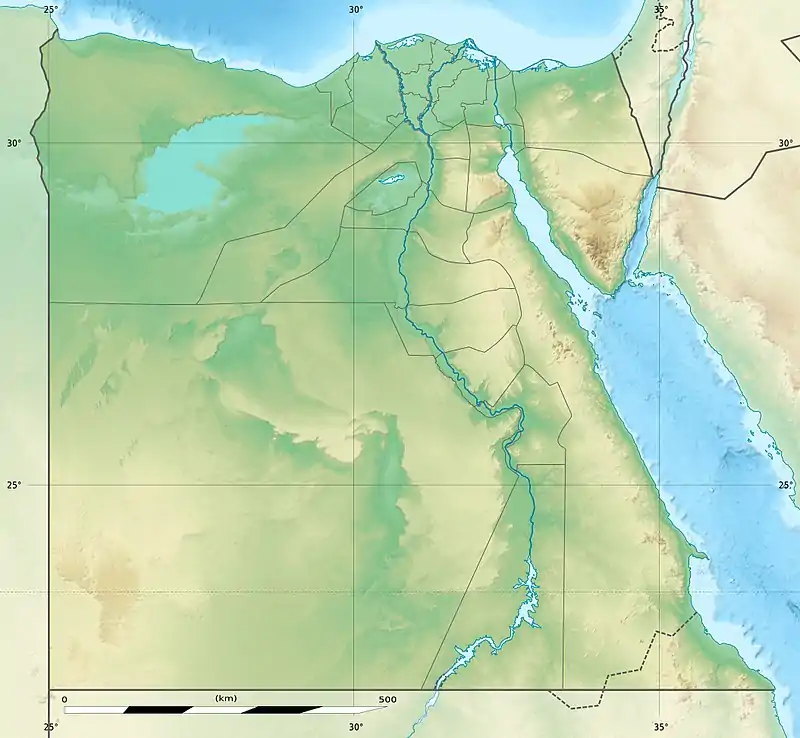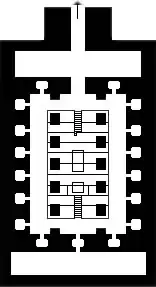 | |
 Shown within Egypt | |
| Location | Abydos, Egypt |
|---|---|
| Coordinates | 26°11′03″N 31°55′06″E / 26.1841°N 31.9184°E |
| Type | Cenotaph |
| History | |
| Builder | Seti I |
| Founded | 13th century BC
19th dynasty of Egypt |
The Osirion or Osireion is the cenotaph of Seti I, located to the rear of the Temple of Seti I at Abydos, Egypt.
It is an integral part of Seti I's temple complex and is possibly built to resemble a Valley of the Kings tomb.[1] The site contains a stone-paved island in the centre, chambers in both wings and, around the island, a water basin of yet undetermined but no less than 10.4 metres (34 ft) depth which was probably used as a well. Access was via a 69 metres (226 ft) stone lined passage.

Modern research
The Osireion was discovered by archaeologists Flinders Petrie and Margaret Murray, who were excavating the site in 1902–03. The Osirion was originally built at a considerably lower level than the foundations of the temple of Seti, who ruled from c. 1294 BC to c. 1279 BC.[2] While, with regard to the depth of the building, its untypical architectural style and its mythological context, there is disagreement as to its true age, in his 1998 dissertation on Seti I, Peter J. Brand, mainly emphasising on the numerous cartouches of Seti I found inscribed at the site, says it "can be dated confidently to Seti's reign".[3]
The Egypt Exploration Society (EES) which carried out the excavations of the site had come to this same conclusion, as detailed in its 1933 two volume excavation report.[4]
Historical accounts
Strabo visited the Osireion in the first century BC and gave a description of the site as it appeared in his time:
Above this city [Ptolemaïs] lies Abydus, where is the Memnonium, a royal building, which is a remarkable structure built of solid stone, and of the same workmanship as that which I ascribed to the Labyrinth, though not multiplex; and also a fountain which lies at a great depth, so that one descends to it down vaulted galleries made of monoliths of surprising size and workmanship.[5]
The subterranean water basin at the Osireion was consequently named "Strabo's Well" by modern excavators.
Strabo then theorises that the Osireion might have been constructed by Ismandes, or Mandes (Amenemhet III, 12th dynasty, who reigned in the 19th and 18th centuries BC), the same purported builder as with the Labyrinth at Hawara:
But if, as they say, Memnon is called Ismandes by the Egyptians, the Labyrinth might be a Memnonium, and the work of the same person who constructed those at Abydos and at Thebes; for in those places, it is said, are some Memnonia.[5]
Strabo's uncertainty about the origins of the structure highly suggests that these were already unknown by the time of his visit. Fortunately, the EES excavations uncovered its identity. “Menmaatre [Seti I] is Benefical to Osiris” was the name given to the subterranean structure.[6] Graffiti by Egyptian priests of Dynasties XXI-XXII found in the long Entrance Passage, the vaulted galleries mentioned by Strabo, hint at its function. “The hidden/secret place of the Underworld/Duat of Menmaatre [Seti I]” and more specifically and revealing as the “Birth House of Isis”.[7]
See also
References
- ↑ Bard, Katheryn (1999). Encyclopedia of the Archaeology of Ancient Egypt. Routledge. p. 114. ISBN 0-415-18589-0.
- ↑ Rice, Michael (1999). Who's Who in Ancient Egypt. Routledge.
- ↑ Brand 2000, p. 175.
- ↑ Frankfort, De Buck & Gunn 1933a, p. 23-25.
- 1 2 Strabo, p. 17.1.42.
- ↑ Frankfort, De Buck & Gunn 1933a, p. 92.
- ↑ Frankfort, De Buck & Gunn 1933a, p. 88-89.
Cited sources
- Brand, Peter J. (2000). "Osireion". The Monuments of Seti I: Epigraphic, Historical and Art Historical Analysis. Brill. pp. 174–178. ISBN 9789004117709.
- Frankfort, Henri; de Buck, Adriaan; Gunn, Battiscombe (1933a). The Cenotaph of Seti I at Abydos: Text. Vol. 1.
- Frankfort, Henri; de Buck, Adriaan; Gunn, Battiscombe (1933b). The Cenotaph of Seti I at Abydos: Plates. Vol. 2.
- Strabo. Geographica. Translated by George Bell & Sons.
Further reading
- Caulfeild, Algernon (1902). The Temple of the Kings at Abydos.
- Murray, Margaret (1904). The Osirion at Abydos.
- Naville, Edouard (1914). "Abydos". The Journal of Egyptian Archaeology. 1 (1): 2–8. doi:10.2307/3853664. JSTOR 3853664.
- O'Connor, David (2009). Abydos: Egypt's First Pharaohs and the Cult of Osiris. London: Thames & Hudson.
- Petrie, Flinders; Murray, Margaret (1903). "The Osirion at Abydos (Abtu)". Egyptian Research Account.
- Roberson, Joshua (2007). "An Enigmatic Wall from the Cenotaph of Seti I at Abydos". JARCE. 43: 93–112.
External links
- Hamilton, Keith (2018). The Osireion: A Layman's Guide.
